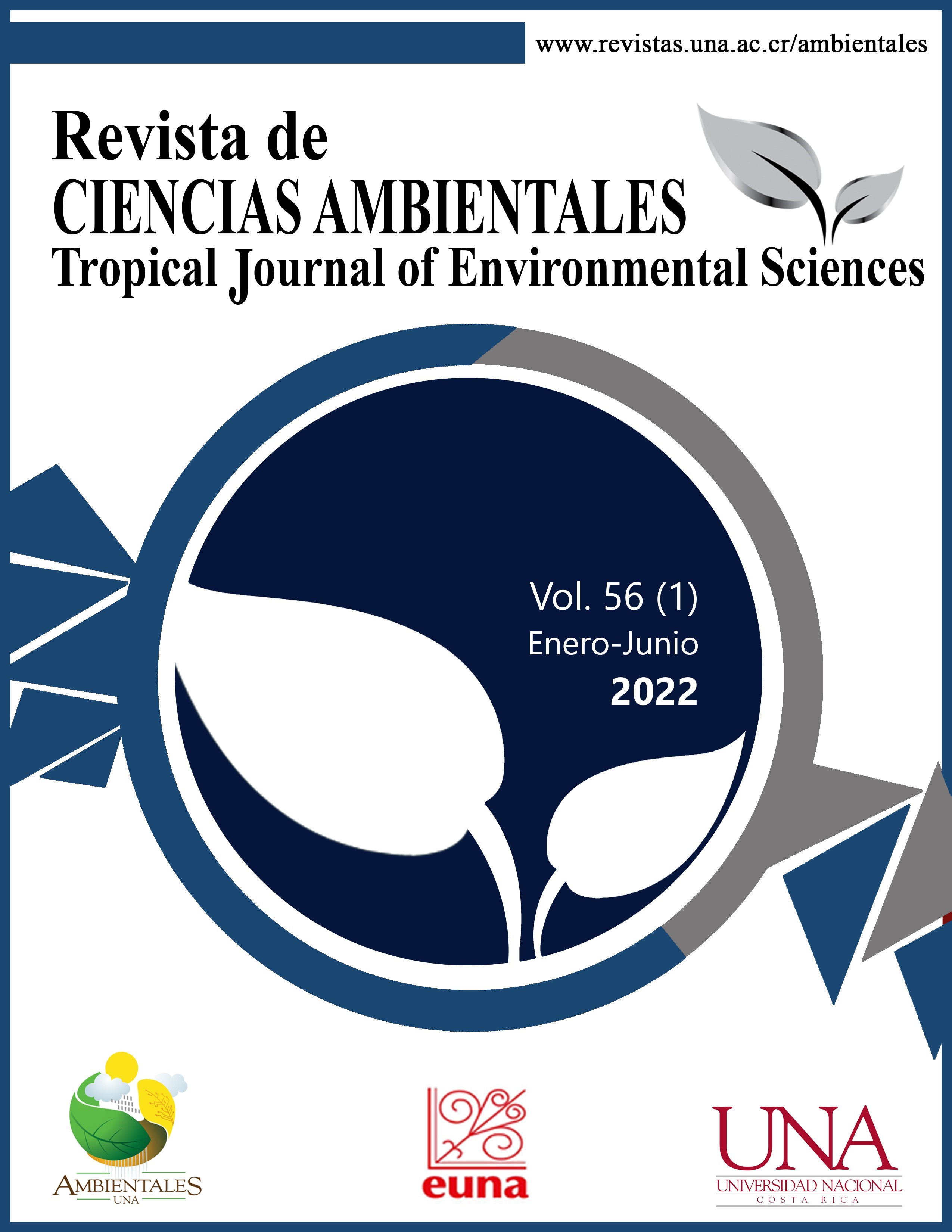Biodiversidad bacteriana presente en suelos contaminados con hidrocarburos para realizar biorremediación
DOI:
https://doi.org/10.15359/rca.56-1.9Palabras clave:
Contaminantes; ecosistemas; metabolismo; microorganismos; poliaromaticos.Resumen
[Introducción]: La biorremediación es una tecnología que utiliza microorganismos (bacterias, hongos, algas) o enzimas, para biodegradar contaminantes del petróleo y derivados y como otros contaminantes que están presentes en suelo, aire o agua. En América Latina existe un alto grado de contaminación de sus ecosistemas; por tanto, esta tecnología es viable económica y ambientalmente para degradar contaminantes. Los hidrocarburos aromáticos policíclicos como asfaltenos y resinas son difíciles de degradar, así como los alifáticos y bifenilos policlorados. [Objetivo]: Se busca dar una visión general de las publicaciones recientes sobre investigaciones científicas realizadas, y metodologías de biorremediación de suelos contaminados por petróleo y sus derivados. [Metodología]: Se realizó una búsqueda exhaustiva de la literatura científica de los últimos años, relacionado al tema propuesto en bases de datos bibliográficas: Medline, Current Contents, PubMed, Google scholar, SciFinder, Scopus y en revistas especializadas: Chemosphere, Microbiología Aplicada, Biodegradation & Biodeterior, Sociedad Americana de Microbiología, Microbiología Frontal, Sci Total Environ. Las palabras clave utilizadas fueron en español o inglés. [Resultados]: Los hidrocarburos poliaromáticos pueden ser biodegradados por diferentes bacterias que biodegradan solas o en consorcio, como el fenantreno (compuesto aromático) que fue biodegradado por 11 cepas bacterianas diferentes (Sphingobium, Sphingomonas, Acidovorax, Alkaligenes, Actinobacteria, Burkholderia sp., Rhizobium sp., Pseudomonas sp., Stenotrophomonas y Sinorhizobium). En biorremediación se considera importante las variables fisicoquímicas, como el pH, temperatura, oxígeno y la humedad, al ser factores que influyen en el éxito del tratamiento. [Conclusiones]: Se buscó aportar con esta revisión, soluciones viables a variados problemas de contaminación por hidrocarburos de los ecosistemas latinoamericanos.
Referencias
Abasolo, F., & Morante, L. A. (2020). Bacterias degradadoras de hidrocarburos a partir de suelos contaminados con hidrocarburos. Colloquium. http://colloquiumbiblioteca.com/index.php/web/article/view/33
Almela, D. M. D. C. (2020). Construyendo materia orgánica en suelos degradados bajo clima semiárido mediante el uso de enmiendas orgánicas (Tesis de doctorado). Universidad de Murcia. http://hdl.handle.net/10201/101951
Araujo J., Y. C. F. V., Barreto C. G. Antequera A. A., De pool B., Rojas Y. (2016). Biocatalizadores fúngicos hidrocarbonoclásticos del genero Aspergillus para la descontaminación de agua con hidrocarburos policíclicos aromáticos (HPAs). Revista Cubana de Quimica, 28, 703-735. https://www.redalyc.org/articulo.oa?id=443546334013
Arrieta Ramírez, O. M. R. R., Ángela Patricia; Arias Marín, Lida; Rojano, Benjamín, & Alberto; Ruiz, O. C. G., Santiago Alonso. (2012). Biorremediación de un suelo con diésel mediante el uso de microorganismos autóctonos. Gestión y Ambiente, 15(1), 27-39. https://www.redalyc.org/articulo.oa?id=169424101004
Auffret, M., Labbe, D., Thouand, G., Greer, C. W., & Fayolle-Guichard, F. (2009). Degradation of a mixture of hydrocarbons, gasoline, and diesel oil additives by Rhodococcus aetherivorans and Rhodococcus wratislaviensis. Appl Environ Microbiol, 75(24), 7774-7782. https://doi.org/10.1128/AEM.01117-09
Arulazhagan, P., Al-Shekri, K., Huda, Q., Godon, J. J., Basahi, J. M., & Jeyakumar, D. (2017). Biodegradation of polycyclic aromatic hydrocarbons by an acidophilic Stenotrophomonas maltophilia strain AJH1 isolated from a mineral mining site in Saudi Arabia. Extremophiles, 21(1), 163-174. https://doi.org/10.1007/s00792-016-0892-0
Azubuike, Ch. Ch., Chikere Ch.B., Okpokwasili G. (2016) Bioremediation techniques–classification based on site of application: principles, advantages, limitations and prospects. World J Microbiol Biotechnol 32:180. https://doi/10.1007/s11274-016-2137-x
Badejo A. C., Chung W. H., Kim N. S., Chai J. C., Lee Y. S., Jung K. H., G., C. Y. (2014). Energy metabolism in Mycobacterium gilvum PYR-GCK: insights from transcript expression analyses following two states of induction. PLoS One, 9(6), e99464. https://doi.org/10.1371/journal.pone.0099464
Bargiela, R., Mapelli, F., Rojo, D., Chouaia, B., Tornes, J., Borin, S., Ferrer, M. (2015). Bacterial population and biodegradation potential in chronically crude oil-contaminated marine sediments are strongly linked to temperature. Sci Rep, 5, 11651. https://doi.org/10.1038/srep11651
Bihari Z., S. A., Szabo Z., Blastyak A., Zombori Z., Balazs M., Kiss I. (2011). Functional analysis of long-chain n-alkane degradation by Dietzia spp. FEMS Microbiol Lett, 316(2), 100-107. https://doi.org/10.1111/j.1574-6968.2010. 02198.x
Uzochukwu Cornelius U., Faith O., Wilson S., Eneh C., Ezogu L. (2021). Bioremediation Strategy Based on Risk Assessment of Exposure to Residual Polycyclic Aromatic Hydrocarbons, Journal of Environmental Management, 2021(208). https://doi.org/10.1016/j.jenvman.2020.111650
Chai L. J., Jiang X. W., Zhang F., Zheng B.W., Shu F.C., Wang Z.L., H., S. Y. (2015). Isolation and characterization of a crude oil degrading bacteria from formation water: comparative genomic analysis of environmental Ochrobactrum intermedium isolate versus clinical strains. J Zhejiang Univ Sci B, 16(10), 865-874. https://doi.org/10.1631/jzus. B1500029
Das, R., Shimamoto, T., & Arifuzzaman, M. (2011). A Novel msDNA (Multicopy Single-Stranded DNA) Strain Present in Yersinia frederiksenii ATCC 33641 Contig01029 Enteropathogenic Bacteria with the Genomic Analysis of It's Retron. J Pathog, 2011, 693769. https://doi.org/10.4061/2011/693769
Desai, A. M., Autenrieth, R. L., Dimitriou-Christidis, P., & McDonald, T. J. (2008). Biodegradation kinetics of select polycyclic aromatic hydrocarbon (PAH) mixtures by Sphingomonas paucimobilis EPA505. Biodegradation, 19(2), 223-233. https://doi.org/10.1007/s10532-007-9129-3
Ding, G. C., Heuer, H., & Smalla, K. (2012). Dynamics of bacterial communities in two unpolluted soils after spiking with phenanthrene: soil type specific and common responders. Front Microbiol, 3, 290. https://doi.org/10.3389/fmicb.2012.00290
Feng L., Jiang X., Huang Y., Wen D., Fu T., Fu R. (2021). Petroleum hydrocarbon-contaminated soil bioremediation assisted by isolated bacterial consortium and sophorolipid. ELSEVIER 273, 15. https://doi.org/10.1016/j.envpol.2021.116476
Fritz, M. (2020). Toxic Ghost Acres, o la dinámica de la eliminación de desechos de producción de petróleo en la Amazonía ecuatoriana, de los años setenta a noventa. Rachel Carson Center, 10, 23-51. https://doi.org/10.32991/2237-2717.2020v10i1.p23-51
Guevara, G.V. (2016). La identidad cultural de los jóvenes Weenhayek con relación a los cambios que atraviesa su sociedad (Tesis de grado). Universidad de Mayor de San Andrés. La Paz.
Ghosal, D., Ghosh, S., Dutta, T. K., & Ahn, Y. (2016). Current State of Knowledge in Microbial Degradation of Polycyclic Aromatic Hydrocarbons (PAHs): A Review. Front Microbiol, 7, 1369. https://doi.org/10.3389/fmicb.2016.01369
Hariyo, D. D. (2020). Comunidades microbianas asociadas a la remoción de fenantreno en suelo: efecto de la aplicación de Medicago sativa L. en el proceso de biorremediación (Tesis doctoral). Universidad Nacional de La plata, Buenos Aires http://sedici.unlp.edu.ar/handle/10915/110010
Hernandez, C. E. O. (2021). El potencial de la biorremediacion. Universidad autonoma de Hidalgo, 2(2), 30-33. https://doi.org/10.29057/h.v2i2.6285
Hernández-Valencia I, L. L. M. y. G. J. V. (2017). Evaluación de la toxicidad de un suelo contaminado con diferentes tipos de crudos sobre la germinación de dos pastos tropicales. BIOAGRO, 29, 73-82.
Hidalgo, K. J., Sierra-Garcia, I. N., Dellagnezze, B. M., & de Oliveira, V. M. (2020). Metagenomic Insights Into the Mechanisms for Biodegradation of Polycyclic Aromatic Hydrocarbons in the Oil Supply Chain. Front Microbiol, 11, 561506. https://doi.org/10.3389/fmicb.2020.561506
Heiss-Blanquet, S., Benoit, Y., Marechaux, C., & Monot, F. (2005). Assessing the role of alkane hydroxylase genotypes in environmental samples by competitive PCR. J Appl Microbiol, 99(6), 1392-1403. https://doi.org/10.1111/j.1365-2672.2005. 02715.x
Ho. M.T., W. B., Yuan Z. Ch. (2017). Complete Genome Sequence of Acinetobacter calcoaceticus CA16, a Bacterium Capable of Degrading Diesel and Lignin. American Society for Microbiology. https://doi.org/10.1128/genomeA.00494-17
Hu, B., Wang, M., Geng, S., Wen, L., Wu, M., Nie, Y., Wu, X. L. (2020). Metabolic Exchange with Non-Alkane-Consuming Pseudomonas stutzeri SLG510A3-8 Improves n-Alkane Biodegradation by the Alkane Degrader Dietzia sp. Strain DQ12-45-1b. Appl Environ Microbiol, 86(8). https://doi.org/10.1128/AEM.02931-19
Huisa B. Dennis X., Loza Del Carpio A. L. Toxic Ghost Acres, o la dinámica de la eliminación de desechos de producción de petróleo en la Amazonia ecuatoriana, de los años setenta a noventa HALAC, v. 10, n.l. https://doi.org/10.32991/2237-2717.2020v10il.p 23-51
Kallimanis, A., Kavakiotis, K., Perisynakis, A., Sproer, C., Pukall, R., Drainas, C., & Koukkou, A. I. (2009). Arthrobacter phenanthrenivorans sp. nov., to accommodate the phenanthrene-degrading bacterium Arthrobacter sp. strain Sphe3. Int J Syst Evol Microbiol, 59(Pt 2), 275-279. https://doi.org/10.1099/ijs.0.000984-0
Kaplan, C. W., & Kitts, C. L. (2004). Bacterial Succession in a Petroleum Land Treatment Unit. Appl Environ Microbiol, 70(3), 1777-1786. https://doi.org/10.1128/aem.70.3.1777-1786.2004
Keum, Y. S., Seo, J. S., Li, Q. X., & Kim, J. H. (2008). Comparative metabolomic analysis of Sinorhizobium sp. C4 during the degradation of phenanthrene. Appl Microbiol Biotechnol, 80(5), 863-872. https://doi.org/10.1007/s00253-008-1581-4
Kouzuma, A., Pinyakong, O., Nojiri, H., Omori, T., Yamane, H., & Habe, H. (2006). Functional and transcriptional analyses of the initial oxygenase genes for acenaphthene degradation from Sphingomonas sp. strain A4. Microbiology, 152(Pt 8), 2455-2467. https://doi.org/10.1099/mic.0.28825-0
Kurth E. G., Doughty D. M., Bottomley P. J., Arp D. J., & A., S.-S. L. (2008). Involvement of BmoR and BmoG in n-alkane metabolism in 'Pseudomonas butanovora'. Microbiology, 154(Pt 1), 139-147. https://doi.org/10.1099/mic.0.2007/012724-0
Lai Q., L. W. a. S. Z. (2012). Complete genome sequence of Alcanivorax dieselolei type strain B5. J Bacteriol, 194(23), 6674. https://doi.org/10.1128/JB.01813-12
Lawniczak, L., Wozniak-Karczewska, M., Loibner, A. P., Heipieper, H. J., Chrzanowski, L. (2020). Molecules. https://doi.org/doi:10.3390/molecules25040856
Liang, Y., Zhao, H., Deng, Y., Zhou, J., Li, G., & Sun, B. (2016). Long-Term Oil Contamination Alters the Molecular Ecological Networks of Soil Microbial Functional Genes. Front Microbiol, 7, 60. https://doi.org/10.3389/fmicb.2016.00060
Liao, J., Wang, J., Jiang, D., Wang, M. C., & Huang, Y. (2015). Long-term oil contamination causes similar changes in microbial communities of two distinct soils. Appl Microbiol Biotechnol, 99(23), 10299-10310. https://doi.org/10.1007/s00253-015-6880-y
López, L., & Infante, C. (2021). Cambios en los Biomarcadores de la fracción de hidrocarburos saturados en un ensayo de biorremediacion con un crudo extra pesado. Revista Internacional de Contaminación Ambiental, 37, 119-131. https://doi.org/10.20937/rica.53718
Lugo, L. L. (2017). Interpretación conceptual del estado actual de la biorremediación realizada por microorganismos sobre hidrocarburos aromáticos policíclicos derivados del petróleo. (Tesis de maestría). Universidad de Manizales. Colombia.
Luning Prak, D. J., & Pritchard, P. H. (2002). Degradation of polycyclic aromatic hydrocarbons dissolved in Tween 80 surfactant solutions by Sphingomonas paucimobilis EPA 505. Canadian Journal of Microbiology, 48(2), 151-158. https://doi.org/10.1139/w02-004
Lyytikäinen M., P. S., Akkanen J., Leppänen M., Kukkonen J. (2007). Bioaccumulation and biotransformation of polycyclic aromatic hydrocarbons during sediment tests with oligochaetes (Lumbriculus variegatus). Wiley-Blackwell, 26(12). https://setac.onlinelibrary.wiley.com/doi/abs/10.1897/01-171.1
Mutnuri, S., Vasudevan, N., & Kaestner, M. (2005). Degradation of anthracene and pyrene supplied by microcrystals and non-aqueous-phase liquids. Appl Microbiol Biotechnol, 67(4), 569-576. https://doi.org/10.1007/s00253-005-1905-6
Milic, J., Beskoski, Vladimir, Ilic, Mila, Ali, Samira, Gojgic-Cvijovic, Gordana Vrvic, Miroslav. (2009). Bioremediation of Soil Heavily Contaminated With Crude Oil and Its Products: Composition of the Microbial Consortium. Journal of the Serbian Chemical Society, 74(4), 455-460. https://doi.org/10.2298/jsc0904455m
Morais, D., Pylro, V., Clark, I. M., Hirsch, P. R., & Totola, M. R. (2016). Responses of microbial community from tropical pristine coastal soil to crude oil contamination. PeerJ, 4, e1733. https://doi.org/10.7717/peerj.1733
Moyna, D. et al. (2021). Valoración Económica de los beneficios sociales del Río Corrientes, ante posibles daños ocasionados por la actividad petrolera en las comunidades aledañas a la plataforma Valencia, Loreto, 2021. Recuperado de. https://www.uahurtado.cl/pdf/Cita_y_Referencia_Bibliogrfica_gua_basada_en_las_normas_APA.pdf
Ocampo H. C. E. (2021). El potencial de la biorremediación. Herreriana.02(2). https://doi.org/10.29057/h.v2i2.6285
Patel, A. B., Shaikh, S., Jain, K. R., Desai, C., & Madamwar, D. (2020). Polycyclic Aromatic Hydrocarbons: Sources, Toxicity, and Remediation Approaches. Front Microbiol, 11, 562813. https://doi.org/10.3389/fmicb.2020.562813
Patel, V., Sharma, A., Lal, R., Al-Dhabi, N. A., & Madamwar, D. (2016). Response and resilience of soil microbial communities inhabiting in edible oil stress/contamination from industrial estates. BMC Microbiol, 16, 50. https://doi.org/10.1186/s12866-016-0669-8
Pathak, A., Chauhan, A., Blom, J., Indest, K. J., Jung, C. M., Stothard, P., Ogram, A. (2016). Comparative Genomics and Metabolic Analysis Reveals Peculiar Characteristics of Rhodococcus opacus Strain M213 Particularly for Naphthalene Degradation. PLoS One, 11(8), e0161032. https://doi.org/10.1371/journal.pone.0161032
Pereda, E. L. (2010). Degradación de alcanos por células de alcanivorax Venustensis inmovilizadas en hidrogeles ddhesivos y biodegradables. Tesis Doctoral.
Rakowska, J. (2020). Remediation of diesel-contaminated soil enhanced with firefighting foam application. Sci Rep, 10(1), 8824. https://doi.org/10.1038/s41598-020-65660-3
Ratledge, C. (1994). Biochemistry of microbial degradation. Department of Applied Biology University of Hull Hull UK: Springer, Dordrecht
Romero, A. R. I. (2013). Biodegradación de HAPs durante la biorremediación aeróbica de suelos contaminados con hidrocarburos del petróleo. Análisis de poblaciones bacterianas y genes funcionales. Tesis Doctoral.
Romero, J. L. (2008). Caracterización Bioquímica y Molecular del Sistema de dos Componentes TODS/TODT de Pseudomonas putida DOT-T1E. Tesis Doctoral.
Ruan, B., Wu, P., Chen, M., Lai, X., Chen, L., Yu, L., Liu, Z. (2018). Immobilization of Sphingomonas sp. GY2B in polyvinyl alcohol-alginate-kaolin beads for efficient degradation of phenol against unfavorable environmental factors. Ecotoxicol Environ Saf, 162, 103-111. https://doi.org/10.1016/j.ecoenv.2018.06.058
Salgado, R., Pineda G., Mesta, A. M., Díaz F., Wang Hu E.T. (2007). Degradación de n-alcanos por Pseudomonas Aeruginosa MGP1. Ciencia y Tecnología, 7(7). https://dialnet.unirioja.es/servlet/articulo?codigo=2986556
Sayed, K, Baloo, L, Kumar N. S (2021). Bioremediation of Total Petroleum Hydrocarbons (TPH) by Bioaugmentation and Biostimulation in Water with Floating Oil Spill Containment Booms as Bioreactor Basin. Environmental research and Public Health. http://doi.org/10.3390/ijerph18052226
Singleton, D. R., Lee, J., Dickey, A. N., Stroud, A., Scholl, E. H., Wright, F. A., & Aitken, M. D. (2018). Polyphasic characterization of four soil-derived phenanthrene-degrading Acidovorax strains and proposal of Acidovorax carolinensis sp. nov. Syst Appl Microbiol. https://doi.org/10.1016/j.syapm.2018.06.001
Silva, C. C., Hayden, H., Sawbridge, T., Mele, P., Kruger, R. H., Rodrigues, M. V., Oliveira, V. M. (2012). Phylogenetic and functional diversity of metagenomic libraries of phenol degrading sludge from petroleum refinery wastewater treatment system. AMB Express, 2(1), 18. https://doi.org/10.1186/2191-0855-2-18
Schuler L., Jouanneau Y., M. Ní, C. S., Christine, M., Maria, P., J., Z. G., N., A. S. (2014). Characterization of a ring-hydroxylating dioxygenase from phenanthrene-degrading Sphingomonas sp. strain LH128 able to oxidize benz[a]anthracene. Appl Microbiol Biotechnol, 465-475. https://doi.org/10.1007/s00253-009-1858-2
Story, S. P., Kline, E. L., Hughes, T. A., Riley, M. B., & Hayasaka, S. S. (2004). Degradation of aromatic hydrocarbons by Sphingomonas paucimobilis strain EPA505. Arch Environ Contam Toxicol, 47(2), 168-176. https://doi.org/10.1007/s00244-004-3069-2
Takeda, H., Shimodaira, J., Yukawa, K., Hara, N., Kasai, D., Miyauchi, K., Fukuda, M. (2010). Dual two-component regulatory systems are involved in aromatic compound degradation in a polychlorinated-biphenyl degrader, Rhodococcus jostii RHA1. J Bacteriol, 192(18), 4741-4751. https://doi.org/10.1128/JB.00429-10
Teramoto, M., Suzuki, M., Hatmanti, A., Harayama, S. (2010). The potential of Cycloclasticus and Altererythrobacter strains for use in bioremediation of petroleum-aromatic-contaminated tropical marine environments. J Biosci Bioeng, 110(1), 48-52. https://doi.org/10.1016/j.jbiosc.2009.12.008
Terrisse, F., Cravo-Laureau, C., Noel, C., Cagnon, C., Dumbrell, A. J., McGenity, T. J., & Duran, R. (2017). Variation of Oxygenation Conditions on a Hydrocarbonoclastic Microbial Community Reveals Alcanivorax and Cycloclasticus Ecotypes. Front Microbiol, 8, 1549. https://doi.org/10.3389/fmicb.2017.01549
Tyagi, M., da Fonseca, M. M., & de Carvalho, C. C. (2011). Bioaugmentation and biostimulation strategies to improve the effectiveness of bioremediation processes. Biodegradation, 22(2), 231-241. https://doi.org/10.1007/s10532-010-9394-4
Vandera, E., & Koukkou, A. I. (2017). Microbial Ecotoxicology: Chapter 9 "Bacterial Community Response to Hydrocarbon Contamination in Soils and Marine Sediments: A Critical Review of Case Studies" Libro, 185-226. https://link.springer.com/chapter/10.1007/978-3-319-61795-4_9
Viñas, M. C. (2005). Biorremediación de suelos contaminados por hidrocarburos: caracterización microbiológica, química y ecotoxicológica. Tesis Doctoral.
Watkinson, R. J. y Morgan, P. (1991). Physiology of aliphatic hydrocarbon-degrading microorganisms. Sittingbourne Research Centre Shell Research Ltd.Sittingbourne, Kent UK. https://doi.org/10.1007/978-94-011-3452-1_1
Wong-Villarreal A., Santiago-Mendez E., Hernández-Núñez E., Yáñez-Ocampo G., Giácoman-Vallejos G., González-Sánchez A., O., L.-B. (2017). Degradación de Fenantreno por bacterias del género Burkholderia y Rhizobium aisladas de nódulos de mimosas. NOVA-Scientia, 9, 291-305. https://doi.org/10.21640/ns.v9i19.995
Xu Y., Y. M., Shen A. (2016). Complete Genome Sequence of the Polychlorinated Biphenyl Degrader Rhodococcus sp. WB1. American Society for Microbiology, 4(5). https://doi.org/10.1128/genomeA.00996-16
Yamazoe A., Y. O. a. O. H. (2004). Biotransformation of fluorene, diphenyl ether, dibenzo-p-dioxin and carbazole by Janibacter sp. Biotechnology Letters, 26. https://doi.org/10.1023/B:BILE.0000019554.49484.40
Zampolli J., C. E., Lasagni M. and Di Gennaro P. (2014). Biodegradation of variable-chain-length n-alkanes in Rhodococcus opacus R7 and the involvement of an alkane hydroxylase system in the metabolism. AMB Express, 4. https://doi.org/10.1186/s13568-014-0073-4
Zanaroli, G., Di Toro, S., Todaro, D., Varese, G. C., Bertolotto, A., & Fava, F. (2010). Characterization of two diesel fuel degrading microbial consortia enriched from a non acclimated, complex source of microorganisms. Microb Cell Fact, 9, 10. https://doi.org/10.1186/1475-2859-9-10
Zhao, Q., Yue, S., Bilal, M., Hu, H., Wang, W., & Zhang, X. (2017). Comparative genomic analysis of 26 Sphingomonas and Sphingobium strains: Dissemination of bioremediation capabilities, biodegradation potential and horizontal gene transfer. Sci Total Environ, 609, 1238-1247. https://doi.org/10.1016/j.scitotenv.2017.07.249
Zhang X., Yang L., Zhang H., Xing W., Wang Y., Bai P., Zhang L., Hayakawa K., Toriba A., Wei Y., Tang N (2021). Assessing Approaches of Human Inhalation Exposure to Polycyclic Aromatic Hydrocarbons: A Review. International journal of Environmental research and Public Health. http://doi.org/10.3390/ijerph18063124
Zhou R., Huang C., Zhang A., Bell S.G., Zhou W., & L.L., W. (2011). Crystallization and preliminary X-ray analysis of CYP153C1 from Novosphingobium aromaticivorans DSM12444. Acta Crystallogr Sect F Struct Biol Cryst Commun, 67(Pt 8), 964-967. https://doi.org/10.1107/S174430911102464X
Publicado
Cómo citar
Número
Sección
Licencia
A partir del 17 de mayo del 2018 la licencia ha sido actualizada a:

Esta obra está bajo una Licencia Creative Commons Atribución-NoComercial-CompartirIgual 4.0 Internacional.



















